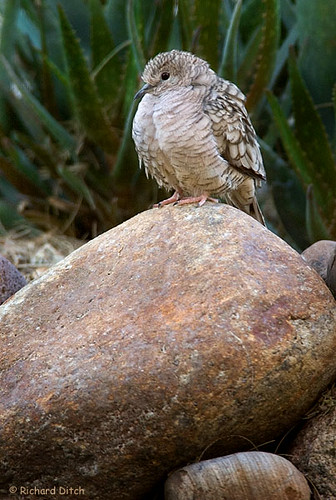tags: Inca Dove, Columbina inca, birds, mystery bird, bird ID quiz
[Mystery bird] Inca Dove, Columbina inca, photographed in Arizona. [I will identify this bird for you tomorrow]
Image: Richard Ditch, 2005 [larger view].
Date Time Original: 2005:03:26 18:18:03
Exposure Time: 1/25
F-Number: 8.00
ISO: 800
Rick Wright, Managing Director of WINGS Birding Tours Worldwide, writes:
Aww! This bird just looks small and harmless, like a baby bird that's lost its momma (more about that below). That said, I'm at a momentary loss as to how I'd go about identifying it if I didn't know the species well already. I can't see much of the tail, so let's give in and look at the head: even with the feathers raised, the head is small for the size of the bird, the eye beady, and the bill weak and undistinguished. The short, sturdy pink feet are also a good clue that we're looking at a pigeon.
Once we've got it to family, it becomes much easier. A closer look at the tail shows that it is long, too long for even Ruddy Ground-Dove (which would be much plainer than this bird, with just a few spots and streaks on the wing and scapulars), and that there is some white on the outer rectrix. It's all falling into place now, and the extensive barring and edging on virtually every feather of this bird leads to the correct identification, Inca Dove.
This is a species notoriously on the march. Inca Doves did not arrive in Arizona until around 1870, and the past couple of decades have seen the species establish a wide vagrancy range across North America, its breeding distribution spreading as well. Most recent records from outside its core range are very well documented, but not a few reports actually refer to Mourning Doves. Yes, Mourning Doves: juveniles of that eminently familiar species can look surprisingly unfamiliar, heavily barred and spotted, and often noticeably smaller than the attending adults; these birds (jestingly known as "Notaninca Doves") are in fact much larger than true Inca Doves, with heavy face patterns, no rufous in the wing, pointed rather than square tails, and at least some black teardrops in the wing coverts. While the wings of Mourning Doves whistle on take-off, Inca Doves produce a dry rattling, like tiny paper sacks being vigorously shaken.


Inca Dove
Oh, it's a roc!
I have no hope of identifying this bird.
Inca Dove Indeed
It does look like an Inca Dove - tiny and scaly. The face doesn't look "very pale" (Sibley's description) to me, but I don't know what else has those charcoal-edged feathers.
Inca Dove. I miss them and their calls--I live fairly out of their range now.
It's a Scaled Dove (Columbina squammata). I'm hearing one singing outside right now. Nice bird, nice Blog!
I once watched an inca dove and a mourning dove pecking up dropped seed under my backyard bird feeder. The inca dove walked at the m.d. and intimidated it into moving away from the good stuff. The m.d. gradually worked its way back toward the main load of seeds, but the inca then walked at the m.d. with its wings open, after which the m.d. withdrew and soon flew away. Then a family of house finches arrived on a telephone wire near the feeder, checking out the menu, and of course not a threat to the inca's ongoing buffet. Nevertheless the inca flew up onto the wire and shuffled sideways toward the finches until they, too, flew away. Once an inca dove is upset, it apparently stays upset.
A very fluffed-out Inca Dove. Though I haven't lived in Arizona in over 35 years, I can still hear their monotonous two note cooing. I kinda miss it.
In fact, I don't know how to tell a silent Inca Dove from a Scaled Dove. The songs--at least as represented at xenocanto--are different, but I haven't had a chance to get to the library or the museum to work out any visual distinctions. Anybody else know anything useful about this pair? (They've often been considered conspecific.)
I've posted a digest of the visual differences between Inca and Scaled Doves at AimAd: just click on my name if you're interested.
Oops--try clicking on my name now!